Cyber-Phishing Website Detection Using Fuzzy Rule Interpolation
Abstract
:1. Introduction
- To identify observable features suitable for detecting the cyber-phishing website’s attacks.
- To identify how the extension of the binary decision to the continuous space handles the intrusion boundaries problem.
- To implement the proposed detection model as a detection mechanism for cyber phishing attacks using fuzzy rule interpolation.
- To compare the results of the proposed detection model with other recent literature results, which had used the same test-bed environment with different algorithms and techniques for detecting cyber phishing website attacks.
2. Related Works
Discussion
- Some of the previous detection methods adapt the binary decision to detect phishing website attacks. However, the binary decision is considered a severe problem for detecting abnormal traffic because there is no formal threshold to determine if the traffic is normal or abnormal.
- The level of attack could not be determined according to the binary decision. Therefore, the anti-phishing alerts need to be more readable and understandable.
- Some of the previous detection methods recorded large values of false alerts, which could lead to time and resource consumption.
- The fuzzy-based detection methods of the previous works required tedious data preprocessing to obtain the anti-phishing rules.
- The fuzzy-based detection methods of the previous works could not handle the issue associated with the deficiencies of the knowledge-based representation.
- The strength of the fuzzy rule interpolation is derived from the fuzzy concept and interpolation technique.
- Using the fuzzy rule interpolation, the issue related to the deficiencies of the knowledge-based representation could be handled by the interpolation techniques.
- The fuzzy rule interpolation effectively smooths the boundaries between normal and abnormal traffic. Therefore, there are no binary decisions.
- Adapting the fuzzy rule interpolation instead of the binary decision system offers the required extension of the binary decision to the continuous space. Hence, the level of attack could be easily measured.
3. Incircle Fuzzy Rule Interpolation
- The first step is to determine the main notations of the Incircle-FRI triangular fuzzy number for the fuzzy rules and the observation’s fuzzy sets.
- The second step is to calculate the interpolation consequent of the Incircle-FRI method in the fuzzy triangular set.
| Algorithm 1 FRI-Incircle Algorithm |
|
- The Incircle-FRI method is characterized by its low computational time and complexity which offers the required quick response for real-time applications such as intrusion detection.
- The Incircle-FRI method follows the fuzzy rule interpolation conditions.
- The Incircle-FRI method supports different types of membership functions for both antecedents and consequent parts, and that includes triangular, trapezoidal, singleton, and hexagonal shaped.
- The Incircle-FRI method facilities similarity propagation of the fuzziness and core between the observation and conclusion.
4. The Suggested FRI-Incircle Detection Method
4.1. Phishing Websites Environment Preparation
- PctExtHyperlinks: it counts the percentage of external hyperlinks in web page HTML source code.
- PctExtResourceUrls: it counts the percentage of external resource URLs in web page HTML source code.
- NumNumericChars: it counts the number of numeric characters in the webpage URL.
- PctExtNullSelfRedirectHyperlinksRT: it counts the percentage of hyperlinks in HTML source code that uses different domain names, starts with #, or using “JavaScript::void(0)”. Apply rules and thresholds to generate the value.
- PctNullSelfRedirectHyperlinks: it counts the percentage of hyperlinks fields containing an empty value, a self-redirect value such as #, the URL of the current webpage, or some abnormal value such as “file://E:/”.
- Design and optimization phase: During this phase, the following requirements should be met. Define the expected inputs and outputs as fuzzy sets. Determine and optimize each membership function for each input/output. In addition, extract the necessary anti-phishing fuzzy rules.
- Testing and Validating Phase: In this phase, the suggested FRI-Incircle method would be tested and evaluated based on various performance metrics in order to determine the efficiency of the suggested method. Additionally, the proposed anti-phishing detection method would be compared to other anti-phishing detection approaches that employed the same testbed environment.
4.2. Design and Optimization Phase
5. Experiments and Results
- Testing the optimized fuzzy sets and anti-phishing sparse rules against the testing data, which is already labeled.
- Investigating the interpolation technique by testing the observations that were not covered by the sparse rules.
- The suggested method was designed based on the strength of fuzzy nature and interpolation techniques.
- The fuzzy nature effectively facilitates the boundaries between benign and phishing attack traffic.
- The output response of the suggested method could be more readable and understandable.
- The output response of the suggested method could lead to defining the attack’s diversity.
- The interpolation technique was able to generate the results (phishing warnings) even in the case of incomplete fuzzy rules.
6. Conclusions
Author Contributions
Funding
Institutional Review Board Statement
Informed Consent Statement
Data Availability Statement
Conflicts of Interest
References
- APWG. Phishing Activity Trends Report: 4th Quarter 2016. In Proceedings of the Anti-Phishing Working Group: APWG Symposium on Electronic Crime Research, Phoenix, AZ, USA, 25–27 April 2017; Volume 12. [Google Scholar]
- APWG. Phishing Activity Trends Report 1 Quarter. In Proceedings of the Anti-Phishing Working Group: APWG Symposium on Electronic Crime Research, San Diego, CA, USA, 15–17 May 2018; pp. 1–12. [Google Scholar]
- Cavit, D.; MM, J.S.; Arroyo, J.; Faulhaber, J.; Pecelj, D.; Seifert, C.; Gullotto, V.; Penta, A.; Simorjay, F.; Wu, S.; et al. Microsoft Security Intelligence Report; Microsoft: Redmond, WA, USA, 2010; Volume 10. [Google Scholar]
- Shirazi, H.; Bezawada, B.; Ray, I. “Know Thy Domain Name” Unbiased Phishing Detection Using Domain Name Based Features. In Proceedings of the Proceedings of the 23nd ACM on Symposium on Access Control Models and Technologies, Indianapolis, IN, USA, 13–15 June 2018; pp. 69–75. [Google Scholar]
- Obeidat, I.; Hamadneh, N.; Alkasassbeh, M.; Almseidin, M.; AlZubi, M. Intensive pre-processing of kdd cup 99 for network intrusion classification using machine learning techniques. Int. J. Interact. Mob. Technol. 2019, 13, 70–83. [Google Scholar] [CrossRef] [Green Version]
- Altaher, A. Phishing websites classification using hybrid svm and knn approach. Int. J. Adv. Comput. Sci. Appl. 2019, 8, 90–95. [Google Scholar] [CrossRef]
- Zuraiq, A.; Mohammad, A.; Al-Kasassbeh, M.; Alnidami, N. Phishing detection based on machine learning and feature selection methods. Int. J. Interact. Mob. Technol. 2019, 13, 171. [Google Scholar]
- Chen, Y.S.; Yu, Y.H.; Liu, H.S.; Wang, P.C. Detect phishing by checking content consistency. In Proceedings of the 2014 IEEE 15th International Conference on Information Reuse and Integration (IEEE IRI 2014), Redwood City, CA, USA, 13–15 August 2014; pp. 109–119. [Google Scholar]
- Alkasassbeh, M.; Al-Naymat, G.; Hassanat, A.; Almseidin, M. Detecting distributed denial of service attacks using data mining techniques. Int. J. Adv. Comput. Sci. Appl. 2016, 7, 436–445. [Google Scholar] [CrossRef] [Green Version]
- Abdelhamid, N.; Ayesh, A.; Thabtah, F. Phishing detection based associative classification data mining. Expert Syst. Appl. 2014, 41, 5948–5959. [Google Scholar] [CrossRef]
- Kumar, K.M.; Alekhya, K. Detecting phishing websites using fuzzy logic. Int. J. Adv. Res. Comput. Eng. Technol. (IJARCET) 2016, 5, 2413–2417. [Google Scholar]
- Almseidin, M.; Alzubi, M.; Kovacs, S.; Alkasassbeh, M. Evaluation of machine learning algorithms for intrusion detection system. In Proceedings of the 2017 IEEE 15th International Symposium on Intelligent Systems and Informatics (SISY), Subotica, Serbia, 14–16 September 2017; pp. 000277–000282. [Google Scholar]
- Aburrous, M.; Hossain, M.A.; Dahal, K.; Thabtah, F. Intelligent phishing detection system for e-banking using fuzzy data mining. Expert Syst. Appl. 2010, 37, 7913–7921. [Google Scholar] [CrossRef]
- Abuzuraiq, A.; Alkasassbeh, M.; Almseidin, M. Intelligent Methods for Accurately Detecting Phishing Websites. In Proceedings of the 2020 11th International Conference on Information and Communication Systems (ICICS), Irbid, Jordan, 7–9 April 2020; pp. 85–90. [Google Scholar]
- Almseidin, M.; Alkasassbeh, M.; Kovacs, S. Fuzzy rule interpolation and snmp-mib for emerging network abnormality. arXiv 2018, arXiv:1811.08954. [Google Scholar] [CrossRef] [Green Version]
- Almseidin, M.; Piller, I.; Al-Kasassbeh, M.; Kovacs, S. Fuzzy automaton as a detection mechanism for the multi-step attack. Int. J. Adv. Sci. Eng. Inf. Technol. 2019, 9, 575–586. [Google Scholar] [CrossRef]
- Almseidin, M.; Kovacs, S. Intrusion detection mechanism using fuzzy rule interpolation. arXiv 2019, arXiv:1904.08790. [Google Scholar]
- Chiew, K.L.; Chang, E.H.; Tiong, W.K. Utilisation of website logo for phishing detection. Comput. Secur. 2015, 54, 16–26. [Google Scholar] [CrossRef]
- Solanki, J.; Vaishnav, R.G. Website phishing detection using heuristic based approach. In Proceedings of the Third International Conference on Advances in Computing, Electronics and Electrical Technology, Kuala Lumpur, Malaysia, 11–12 April 2015; pp. 87–92. [Google Scholar]
- Lee, J.L.; Kim, D.H.; Chang-Hoon, L. Heuristic-based approach for phishing site detection using url features. In Proceedings of the Third International Conference on Advances in Computing, Electronics and Electrical Technology-CEET, Kuala Lumpur, Malaysia, 11–12 April 2015; pp. 131–135. [Google Scholar]
- Alzubi, M.; Kovacs, S. Interpolative fuzzy reasoning method based on the incircle of a generalized triangular fuzzy number. J. Intell. Fuzzy Syst. 2020, 39, 709–729. [Google Scholar] [CrossRef]
- Mohammad, R.; Thabtah, F.A.; McCluskey, T. Phishing Websites Dataset. 2015. Available online: http://eprints.hud.ac.uk/id/eprint/24330/ (accessed on 20 March 2022).
- Chiew, K.L.; Tan, C.L.; Wong, K.; Yong, K.S.; Tiong, W.K. A new hybrid ensemble feature selection framework for machine learning-based phishing detection system. Inf. Sci. 2019, 484, 153–166. [Google Scholar] [CrossRef]
- Tan, C.L. Phishing Dataset for Machine Learning: Feature Evaluation. Published: 24 March 2018, Version 1. Available online: https://data.mendeley.com/datasets/h3cgnj8hft/1 (accessed on 20 March 2022).
- He, M.; Horng, S.J.; Fan, P.; Khan, M.K.; Run, R.S.; Lai, J.L.; Chen, R.J.; Sutanto, A. An efficient phishing webpage detector. Expert Syst. Appl. 2011, 38, 12018–12027. [Google Scholar] [CrossRef]
- Al-Kasassbeh, M.; Almseidin, M.; Alrfou, K.; Kovacs, S. Detection of IoT-botnet attacks using fuzzy rule interpolation. J. Intell. Fuzzy Syst. 2020, 39, 421–431. [Google Scholar] [CrossRef]
- Alzubi, M.; Almseidin, M.; Lone, M.A.; Kovacs, S. Fuzzy Rule Interpolation Toolbox for the GNU Open-Source OCTAVE. In Proceedings of the 2019 17th International Conference on Emerging eLearning Technologies and Applications (ICETA), Stary Smokovec, Slovakia, 21–22 November 2019; pp. 16–22. [Google Scholar]
- Almseidin, M.; Al-Sawwa, J.; Alkasassbeh, M. Anomaly-based Intrusion Detection System Using Fuzzy Logic. In Proceedings of the 2021 International Conference on Information Technology (ICIT), Amman, Jordan, 14–15 July 2021; pp. 290–295. [Google Scholar] [CrossRef]
- Almseidin, M.; Al-Kasassbeh, M.; Kovacs, S. Detecting slow port scan using fuzzy rule interpolation. In Proceedings of the 2019 2nd International Conference on new Trends in Computing Sciences (ICTCS), Amman, Jordan, 9–11 October 2019; pp. 1–6. [Google Scholar]
- Altarawneh, G.A.; Hassanat, A.B.; Tarawneh, A.S.; Carfì, D.; Almuhaimeed, A. Fuzzy Win-Win: A Novel Approach to Quantify Win-Win Using Fuzzy Logic. Mathematics 2022, 10, 884. [Google Scholar] [CrossRef]
- Hassanat, A.B.; Tarawneh, A.S.; Abed, S.S.; Altarawneh, G.A.; Alrashidi, M.; Alghamdi, M. RDPVR: Random Data Partitioning with Voting Rule for Machine Learning from Class-Imbalanced Datasets. Electronics 2022, 11, 228. [Google Scholar] [CrossRef]
- Kovács, S. Fuzzy Rule Interpolation. In Encyclopedia of Artificial Intelligence; IGI Global: Hershey, PA, USA, 2009; pp. 728–733. [Google Scholar]
- Johanyák, Z.C. Sparse fuzzy model identification matlab toolox-rulemaker toolbox. In Proceedings of the 2008 IEEE International Conference on Computational Cybernetics, Stara Lesná, Slovakia, 27–29 November 2008; pp. 69–74. [Google Scholar]
- Johanyak, Z.C.; Kovacs, S. Sparse Fuzzy System Generation by Rule Base Extension. In Proceedings of the 2007 11th International Conference on Intelligent Engineering Systems, Budapest, Hungary, 29 June–2 July 2007; pp. 99–104. [Google Scholar] [CrossRef]
- Johanyak, Z.; Tikk, D.; Kovacs, S.; Wong, K.W. Fuzzy Rule Interpolation Matlab Toolbox—FRI Toolbox. In Proceedings of the 2006 IEEE International Conference on Fuzzy Systems, Vancouver, BC, Canada, 16–21 July 2006; pp. 351–357. [Google Scholar] [CrossRef] [Green Version]
- Hassanat, A.B.; Ali, H.N.; Tarawneh, A.S.; Alrashidi, M.; Alghamdi, M.; Altarawneh, G.A.; Abbadi, M.A. Magnetic Force Classifier: A Novel Method for Big Data Classification. IEEE Access 2022, 10, 12592–12606. [Google Scholar] [CrossRef]

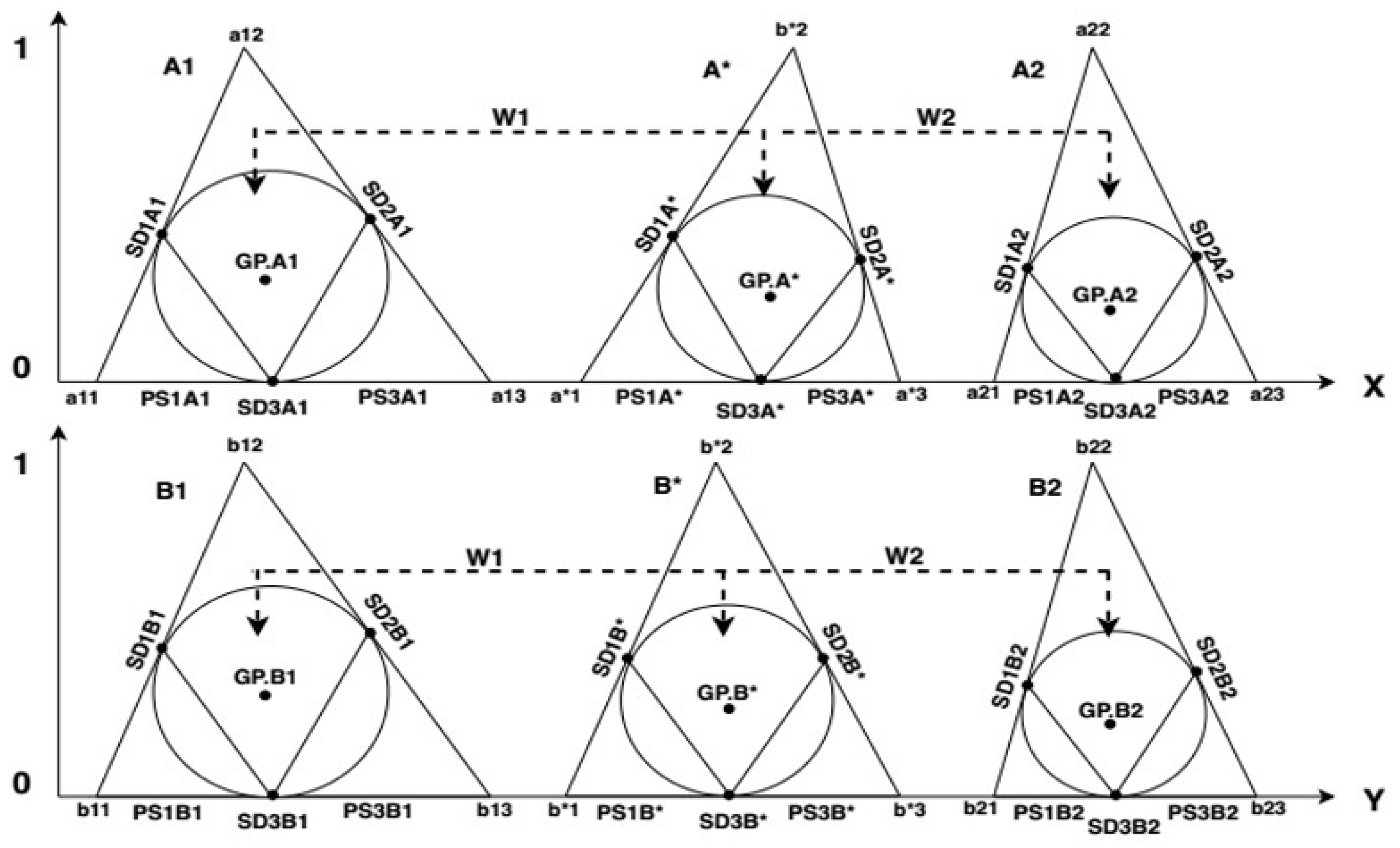

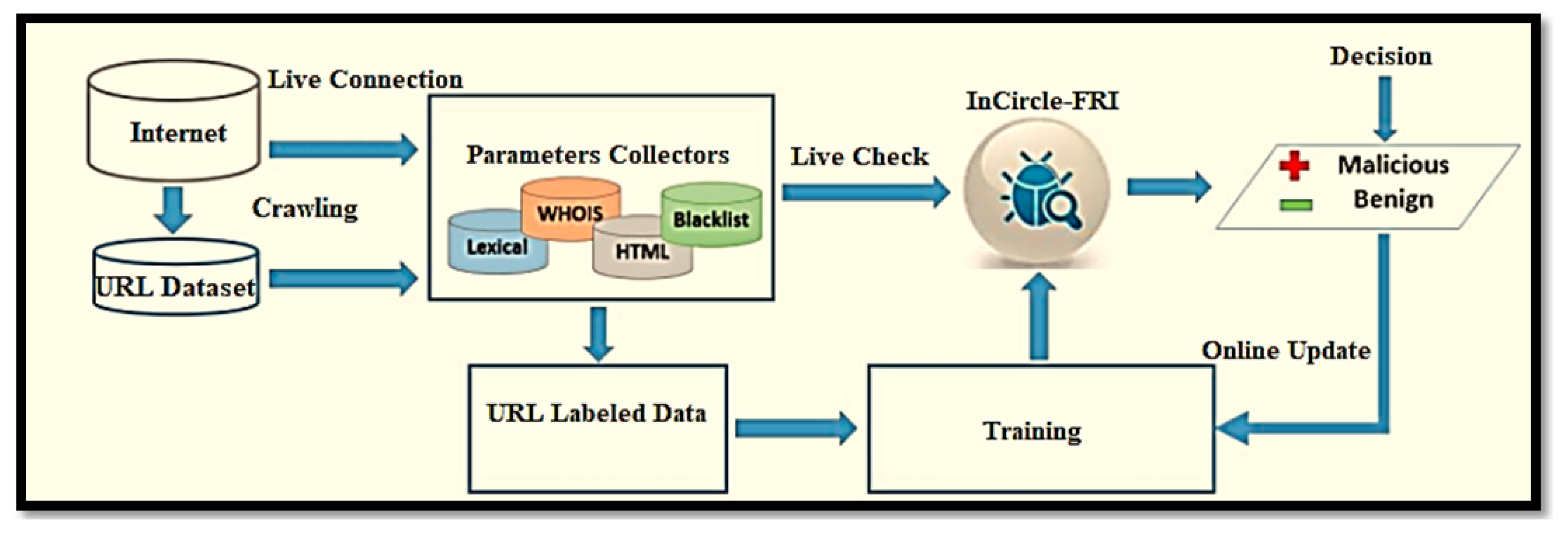
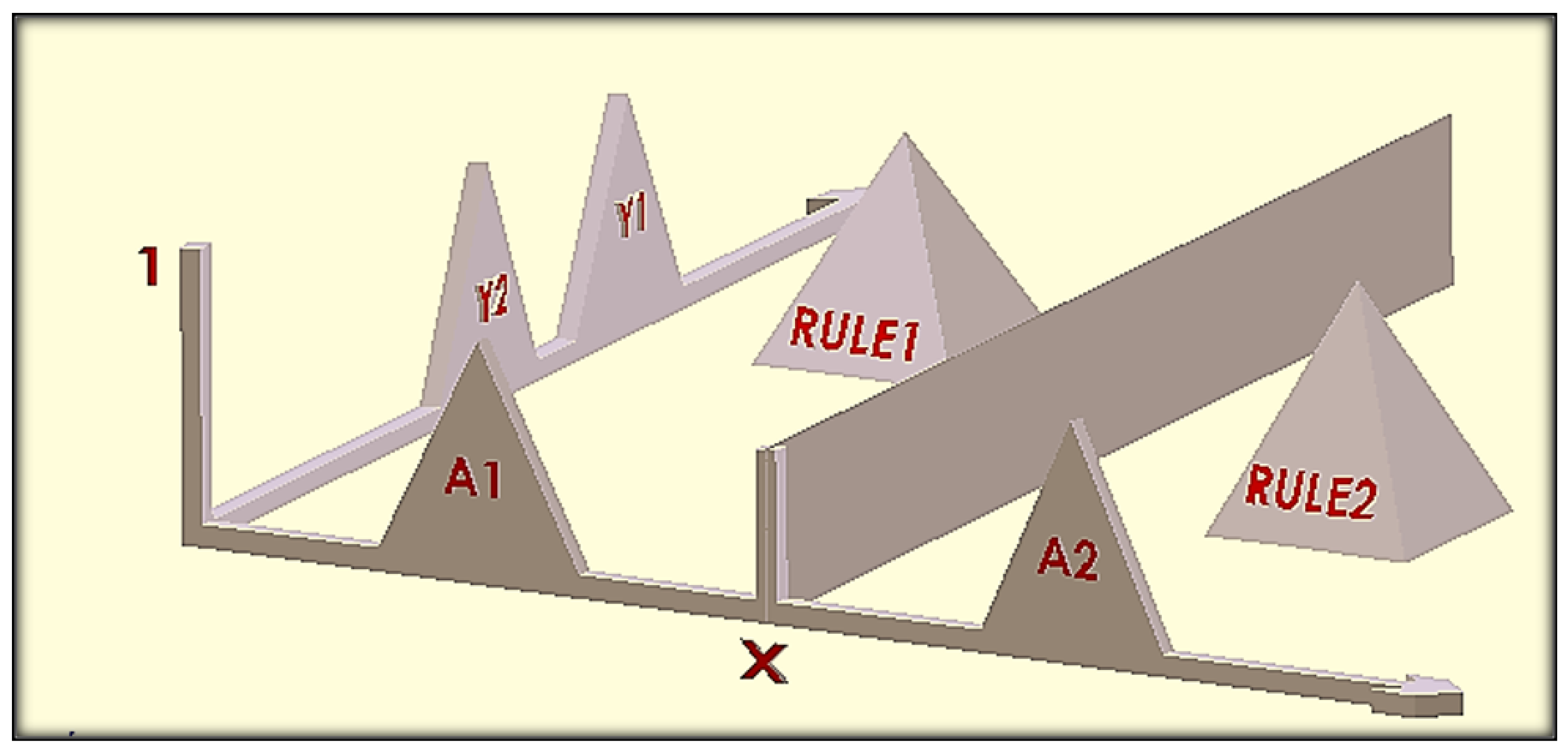
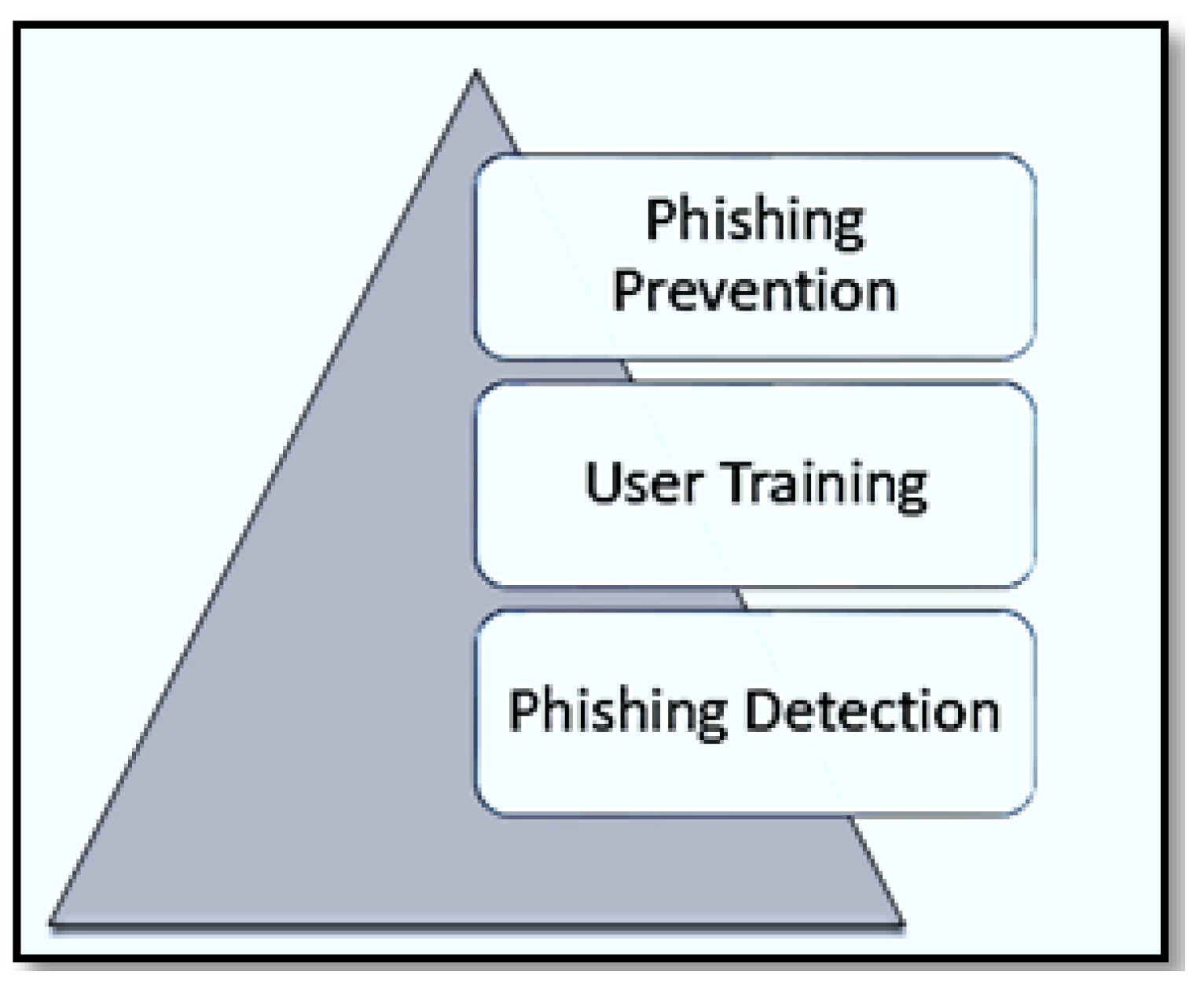

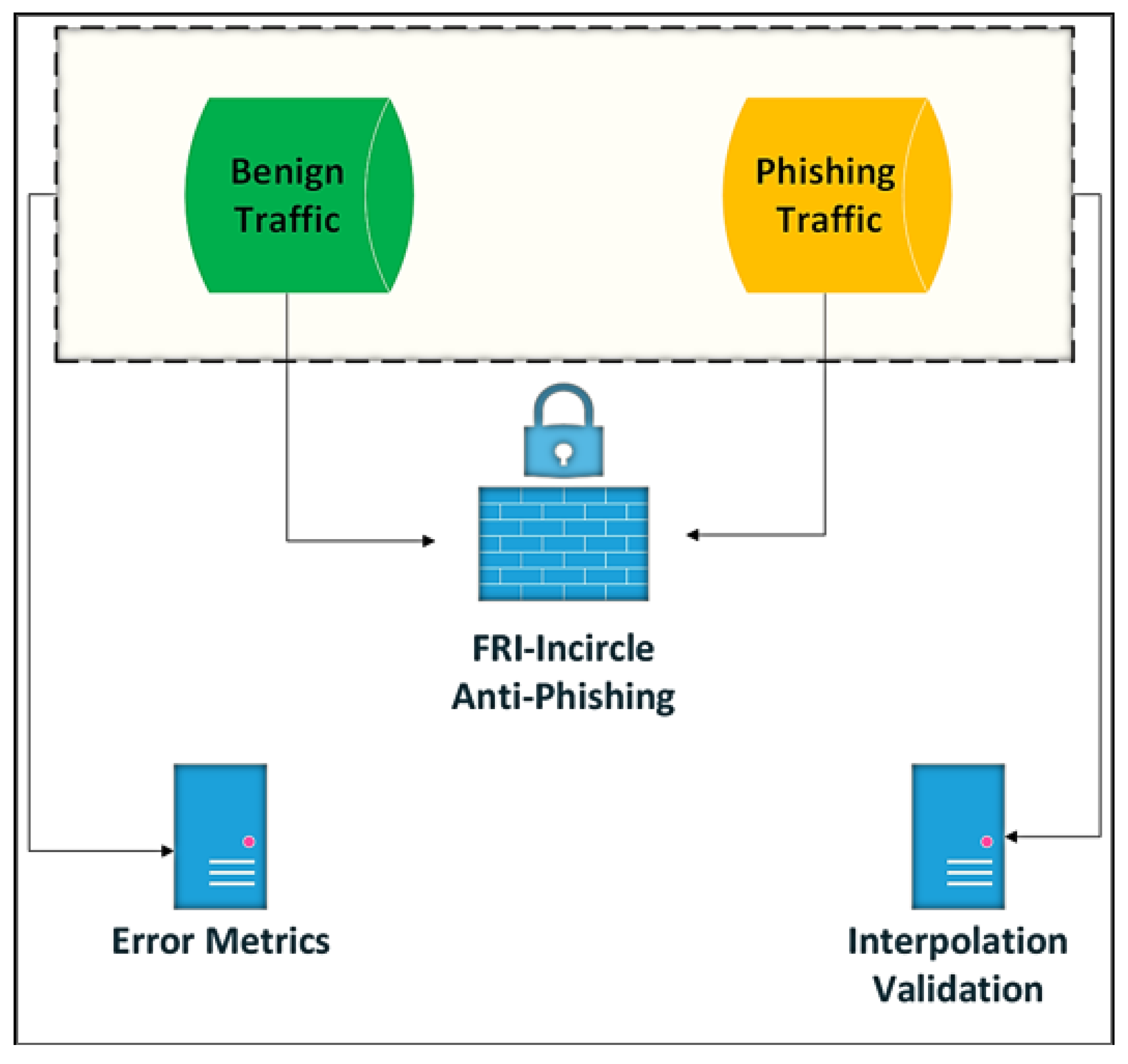

| Index | Input Parameters | Linguistic Terms |
|---|---|---|
| 1 | PctExtHyperlinks | vLow, Low, Medium, High |
| 2 | PctExtResourceUrls | vLow, Low, Medium, High |
| 3 | NumNumericChars | vLow, Low, Medium, High |
| 4 | PctExtNullSelfRedirectHyperlinksRT | Low, Medium, High |
| 5 | PctNullSelfRedirectHyperlinks | Low, Medium, High |
| Num | PctExtHyperlinks | PctExtResourceUrls | NumNumericChars | PctExtNullSelfRedirectHyperlinksRT | PctNullSelfRedirectHyperlinks | Output Response |
|---|---|---|---|---|---|---|
| 1 | vLow | vlow | Low | Low | Low | Benign |
| 2 | High | vhigh | Low | Low | Medium | Phishing Attack |
| 3 | Low | Medium | vHigh | High | Low | Phishing Attack |
| 4 | Low | Medium | Low | Low | Medium | Benign |
| 5 | Medium | High | Medium | Medium | High | Phishing Attack |
| 6 | Low | vLow | vLow | High | Low | Benign |
| 7 | vLow | vHigh | vHigh | High | High | Phishing Attack |
| 8 | Low | vLow | Low | Low | Medium | Benign |
| Num | Performance Metrics | Value |
|---|---|---|
| 1 | Sensitivity | 0.9780 |
| 2 | Specificity | 0.9732 |
| 3 | Precision | 0.9780 |
| 4 | Negative Predictive Value | 0.9732 |
| 5 | False Positive Rate | 0.0268 |
| 6 | False Negative Rate | 0.0220 |
| 7 | Computation Time | 180 min |
| 8 | Accuracy | 0.9758 |
| Comparison | Algorithm | A |
|---|---|---|
| [7] (2019) | SVM | 0.92 |
| [7] (2019) | Naïve Bayes | 0.90 |
| [7] (2019) | KNN+SVM | 0.90 |
| [6] (2019) | Multilayer Perceptron | 0.91 |
| [6] (2019) | J48 | 0.95 |
| [6] (2019) | Random Forest | 0.95 |
| [34] (2022) | BaggedBFTree | 0.96 |
| [34] (2022) | BaggedNBTree | 0.95 |
| [34] (2022) | BoostedBFTree | 0.97 |
| [35] (2022) | Functional Tree | 0.96 |
| The Proposed Method | Incircle-FRI | 0.97 |
Publisher’s Note: MDPI stays neutral with regard to jurisdictional claims in published maps and institutional affiliations. |
© 2022 by the authors. Licensee MDPI, Basel, Switzerland. This article is an open access article distributed under the terms and conditions of the Creative Commons Attribution (CC BY) license (https://creativecommons.org/licenses/by/4.0/).
Share and Cite
Almseidin, M.; Alkasassbeh, M.; Alzubi, M.; Al-Sawwa, J. Cyber-Phishing Website Detection Using Fuzzy Rule Interpolation. Cryptography 2022, 6, 24. https://doi.org/10.3390/cryptography6020024
Almseidin M, Alkasassbeh M, Alzubi M, Al-Sawwa J. Cyber-Phishing Website Detection Using Fuzzy Rule Interpolation. Cryptography. 2022; 6(2):24. https://doi.org/10.3390/cryptography6020024
Chicago/Turabian StyleAlmseidin, Mohammad, Mouhammad Alkasassbeh, Maen Alzubi, and Jamil Al-Sawwa. 2022. "Cyber-Phishing Website Detection Using Fuzzy Rule Interpolation" Cryptography 6, no. 2: 24. https://doi.org/10.3390/cryptography6020024
APA StyleAlmseidin, M., Alkasassbeh, M., Alzubi, M., & Al-Sawwa, J. (2022). Cyber-Phishing Website Detection Using Fuzzy Rule Interpolation. Cryptography, 6(2), 24. https://doi.org/10.3390/cryptography6020024








